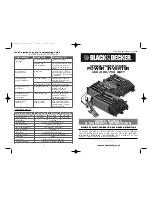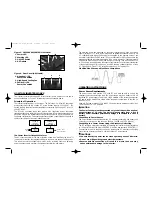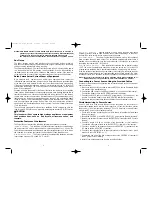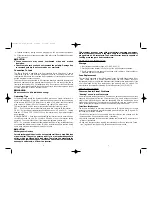
3
The modified sine wave produced by the Power Inverter has an RMS (root mean
square) voltage of 115 volts, which is the same as standard household power. Most
AC voltmeters (both digital and analog) are sensitive to the average value of the
waveform rather than the RMS value. They are calibrated for RMS voltage under the
assumption that the waveform measured will be a pure sine wave. These meters will
not read the RMS voltage of a modified sine wave correctly. They will read about 20
to 30 volts low when measuring the output of the inverter. For accurate measurement
of the output voltage of this unit, use a true RMS reading voltmeter such as a Fluke
87, Fluke 8060A, Fluke 77/99 series, Beckman 4410, or Triplett 4200.
Modified Sine Wave and Sine Wave Comparison
OPERATING INSTRUCTIONS
Power Source Requirements
The power source must provide 12.5 volts DC and must be able to supply the
necessary current to operate the load. The power source may be a battery or a well-
regulated DC power supply. To obtain a rough estimate of the current (in amperes)
the power source must deliver, simply divide the power consumption of the load (in
watts AC) by 10.
Example: If a load is rated at 200 watts AC, the power source must be able to deliver:
200 divided by 10 = 20 amperes
CAUTION
The Power Inverter must be connected only to batteries with a nominal
output voltage of 12 volts. The unit will not operate from a 6 volt
battery and will sustain permanent damage if connected to a 24 volt
battery.
Connection to Power Source
The Power Inverter comes equipped with a DC accessory outlet plug and battery clip
cables for connection to a power source (Models 1045BD and 1046 BD only).
Connecting to a Power Source Using the Accessory Outlet Plug
The DC accessory outlet plug is suitable for operating the inverter at power outputs up
to 100 watts. The tip of the plug is POSITIVE (+) and the side contact is NEGATIVE (–).
Connect the inverter to the power source by inserting the DC accessory outlet plug
firmly into the accessory outlet of a vehicle or other DC power source.
CAUTIONS
• Connect directly to power source when operating above 100 watts.
• Do not use with positive ground electrical systems.
• Reverse polarity connection will result in a blown fuse and may
cause permanent damage to the inverter.
2
HOW THIS INVERTER WORKS
The inverter converts low voltage DC (direct current) from a battery or other power
source to standard 120 volt AC (alternating current) household power.
Principle of Operation
The inverter converts power in two stages. The first stage is a DC-to-DC conversion
process that raises the low voltage DC at the inverter input to 145 volts DC. The
second stage is the actual inverter stage that converts the high voltage DC into 115
volts, 60 Hz AC.
The DC-to-DC converter stage uses modern high frequency power conversion
techniques that have replaced the bulky transformers found in less technologically-
advanced models. The inverter stage uses advanced power MOSFET transistors in a
full bridge configuration. This ensures excellent overload capability and the ability to
operate reactive loads like small induction motors.
The Power Inverter Output Waveform
The AC output waveform of the Power Inverter is known as “modified sine wave.” It
is a waveform that has characteristics similar to the sine wave shape of utility power.
This type of waveform is suitable for most AC loads, including linear and switching
power supplies used in electronic equipment, transformers, and motors.
12VDC to
145VDC
CONVERSION
145VDC to
115VAC
CONVERSION
Internal
Fuses
Two AC
Outlets
12VDC
Input
115VAC, 60Hz
to AC appliances
Figure 4. Rear Panel (All Models)
1. Negative (–) DC
Power Connection
2. High-Speed Cooling Fan
3. Positive (+) DC
Power Connection
2222
3333
1111
1. Power LED
2. Warning LED
3. ON/OFF Switch
4. AC Outlets
2222
1111
4444
3333
Figure 2. VEC1046BD/1047BD Front Panel
VEC1045_46_47_BD_Manual 4/28/05 5:16 PM Page 2
























